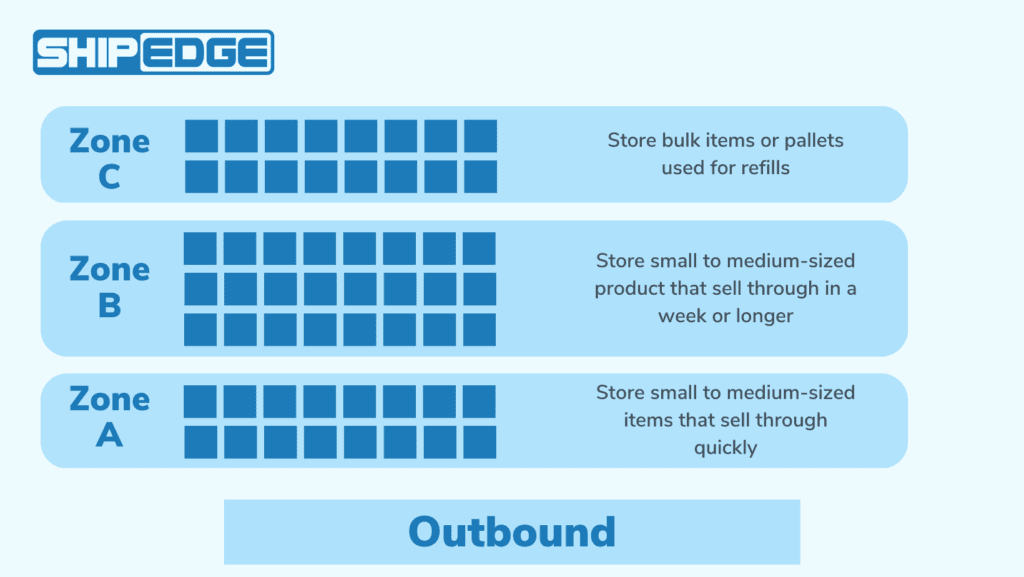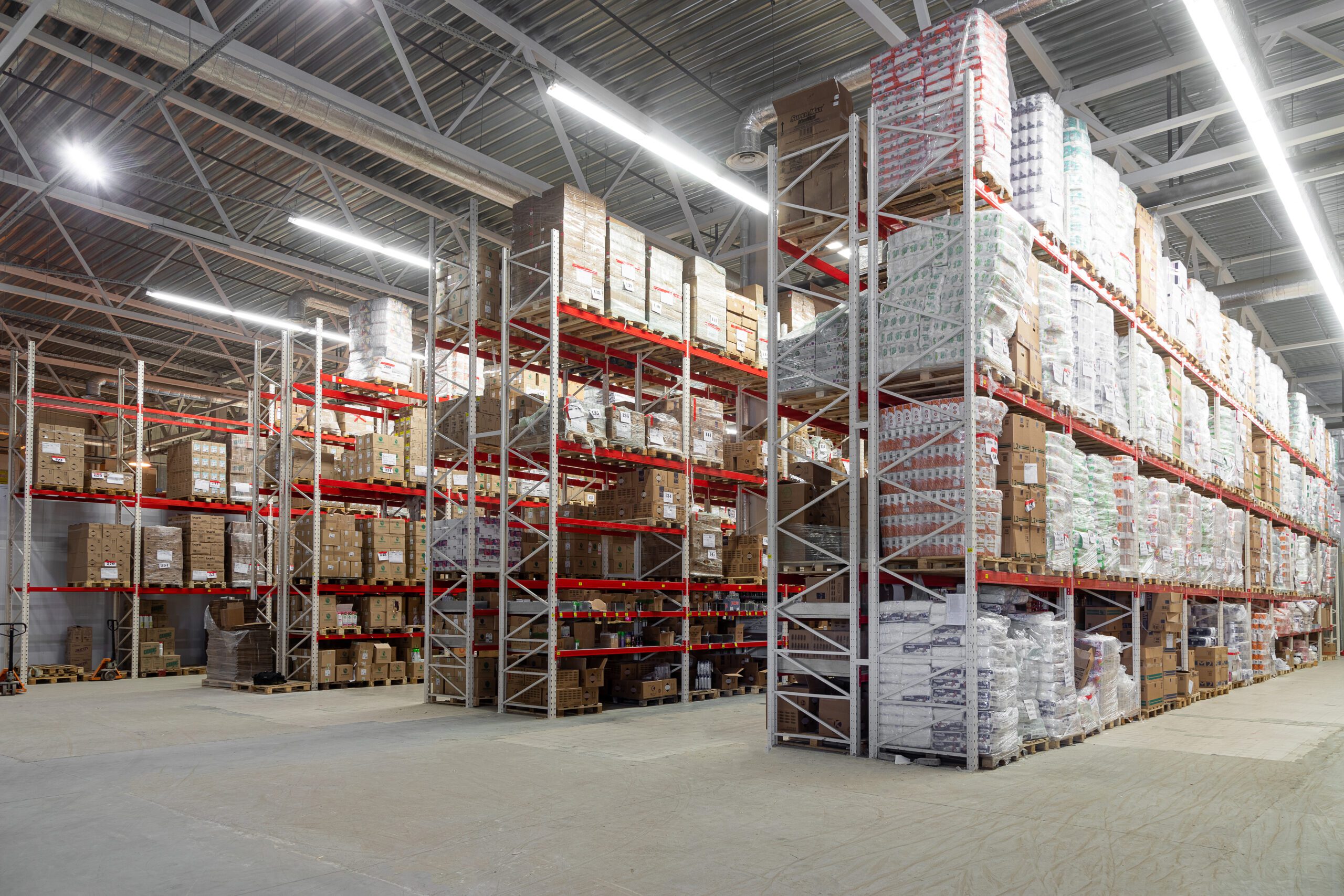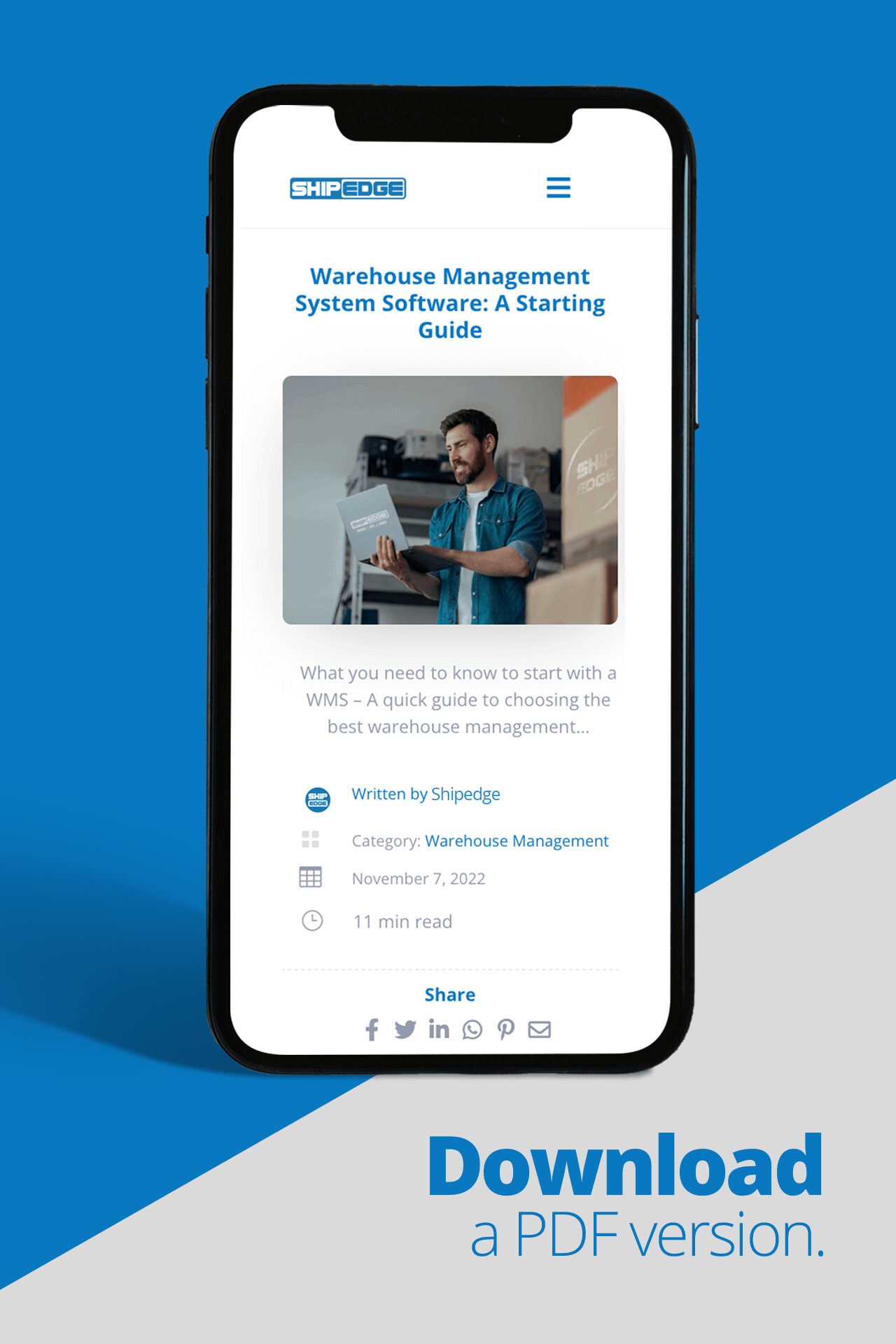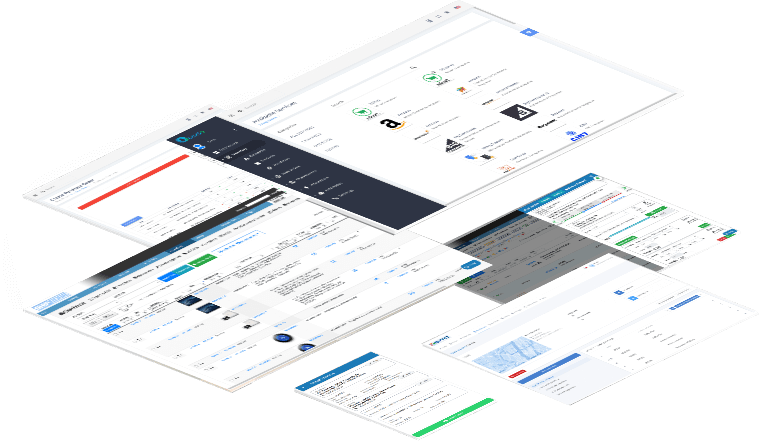The growth of eCommerce has increasingly highlighted the importance that logistics companies, such as thirty-party logistics (3PL) providers and eCommerce warehouse owners, must place on the design and layout of warehouses.
Optimizing your warehouse layout and implementing an effective inventory management system can boost efficiency and productivity, reduce expenses, streamline operations, improve storage utilization, ensure customer satisfaction, and more. This article will present common questions about warehouse layout optimization and how it can improve a company’s performance and introduce Shipedge’s WMS, a powerful solution to help improve your warehouse management.
What is Warehouse Layout Optimization?
Warehouse layout optimization is designing or redesigning a warehouse’s physical space to maximize it, reduce operating costs, and increase efficiency.
This process will allow companies to smoothly facilitate the flow of goods and traffic, streamline operations from receiving to shipping, and help manage demand effectively without sacrificing quality.
Effective warehouse layout design is crucial at all stages of eCommerce management and significantly impacts logistics costs and profitability. Implementing an efficient warehouse layout design can help businesses maximize their resources. Order picking is one of the most costly warehouse activities and should be optimized first to create a more efficient warehouse.
Why Having a Warehouse Layout Design is Essential
Designing a practical and optimized warehouse layout is crucial for businesses that want to enhance efficiency and productivity. A well-planned layout should organize processes in a logical sequence:
- Streamline operations
- Boost productivity
- Reduce expenses
The layout and design of the warehouse should also consider all business requirements during the planning phase to avoid costly changes during facility construction. With an optimized warehouse layout, businesses can improve order fulfillment rates, minimize travel time, reduces stock losses, boosts overall efficiency, and quickly access stored goods.
Discover how our WMS can improve your business
IMPROVE YOUR WAREHOUSE’S LAYOUT
Creating an optimal warehouse design is essential for retail and manufacturing businesses to enhance profitability and attain objectives.
In today’s competitive business environment, an optimized warehouse layout is necessary to meet customer demands and streamline operations. The design heavily impacts productivity, which can increase costs if done incorrectly. Businesses should focus on gaining more and losing less by implementing an efficient warehouse layout design. By doing so, they can ensure successful warehouse operations and stay competitive in the market.
The Advantages of Optimizing Warehouse Layouts
Thus far, we have emphasized the significance that implementing an optimized layout in your warehouse can have on the longevity of your company. Below we highlighted other advantages that this implementation could bring to your business, including:
Maximization of space
There are several techniques designed to improve the performance of any warehouse. Among them, the use of vertical space and the utilization of corridors stand out. Using these techniques allows your floor employees to find products much easier. In addition to more efficient routing of products, the total available warehouse space will improve considerably. With the scarcity of warehouse space increasing, you don’t want to be paying for warehouse space that you’re not using.
READ MORE: Seven vital warehouse software features for e-commerce warehouse
Improving Product Placement and Organization
This advantage can be one of the most significant for any company seeking to optimize its warehouse’s performance. It can become even more crucial for third-party logistics providers (3PLs) that work directly with businesses selling seasonal products or food items such as fruits or vegetables.
With effective management and a well-optimized warehouse, it becomes possible to monitor all products entering or leaving the facility, determine where to store them, and establish the proper order for entry and exit.
To achieve this, various storage methods can be utilized, including:
- First In First Out (FIFO): A stock rotation and separation method that determines the order in which a batch enters and leaves the warehouse. In the FIFO rotation, the first batch to arrive at the warehouse is also the first to leave. This method is usually better for warehouses that have inventory that could expire.
- Last In First Out (FIFO): The opposite of FIFO, this method determines how batches leave and enter the warehouse. In the LIFO rotation, the last batch to arrive at the warehouse is the first one shipped out. This method is usually better for warehouses that have nonperishable products.
There are many other styles of inventory rotation to explore.
Discover how our WMS can improve your business
Increased Productivity
An optimized warehouse layout will improve the flow of goods and traffic, reducing the time to complete tasks and increasing overall productivity. This is undoubtedly a very competitive advantage that will facilitate the work of your employees, who will have more time in their day to focus on other essential tasks.
READ MORE: Maximize your e-commerce success with real-time inventory management
Improve Customer Satisfaction
A general concern of every business is implementing strategies that directly impact customer satisfaction. By focusing on obtaining better management of your warehouse, you will be able to meet the different needs of consumers more quickly. This will improve customer satisfaction, increase brand trust, and lead to more repeat purchases.
READ MORE: How to ship more for less cartonization & best shipping rate
Monitoring Improvement
An efficient warehouse will have the tools to capture specific data and convert it into helpful metrics that can be measured and reported in easily digital charts and dashboards. Key Performance Indications (KPIs) will help your company:
- Increase receiving efficiency or productivity: Know the exact numbers of goods received per warehouse operator per hour. Lower scores indicate that there may have problems to investigate, otherwise higher scores indicate greater receiving efficiency.
- Increase picking accuracy: Matches the number of orders accurately picked divided by the total number of orders picked. The closer to 100% accuracy, the better.
- Reduce order lead time: For the highest customer satisfaction, the shorter the lead time should be.
- Rate of product return: This KPI reflects the efficiency of inventory management in meeting demand within a specified period. It’s calculated by dividing the total cost of goods sold during that period by the average price of inventory maintained during the same period.
- Understanding the consumers’ feedback will be perfect for understanding what is doing well or what is needed to change.
READ MORE: Six simple solutions to boost productivity for the small business owner
Greater Flexibility
A well-organized warehouse can handle changes in demand more easily and quickly, allowing a business to adapt to market changes and stay competitive.
Improve Inventory Control
Efficient warehouse processes can help businesses manage inventory more effectively, reducing the risk of overstocking or stockouts and minimizing the need for costly inventory management practices.
Enhance Safety
An optimized warehouse layout can minimize the risk of accidents and injuries, making the workplace safer for employees and visitors.
These are just a few advantages you can access when you optimize the organization of the layout of your warehouse. Always remember that an efficient warehouse can help a business achieve its goals by improving productivity, reducing costs, enhancing customer satisfaction, and providing greater flexibility and control over inventory management. But how should we design our warehouse to maximize efficiency, and who can help us?
Discover how our WMS can improve your business
How to Design an Efficient Warehouse
Now that we’ve explored some of the main benefits of implementing an optimized warehouse layout in your company, it’s important to know, in this second stage, some procedures that should be implemented to optimize the efficiency of your warehouse layout. Let´s meet some of them.
Steps to Improve the Efficiency of Your Warehouse
When establishing a warehouse, carefully selecting its location is crucial for ensuring efficient operations within the facility.
To do that, it is also important to conduct a thorough analysis of factors such as:
1. Develop a location plan
Carefully select the warehouse location, considering factors such as:
- Soil permeability and composition
- Humidity levels
- Proximity to stores or customers
Elements such as humidity, soil quality, and the likelihood of natural disasters may pose a risk to the goods stored in the warehouse, resulting in significant physical and financial losses over time. It’s best to have actionable plans in place to counteract these factors.
Additionally, the geographical location of the warehouse in relation to physical stores or customers may play a factor in your business plans. The location of your warehouse could impact shipping times.
Lastly, take into consideration other building features, such as pillars, walls, and piping, that could impact internal processes.
2. Create Zones or Areas
The creation of zones should be one of the first steps you take to improve the efficiency of your warehouse. Creating zones or areas will help you organize your warehouse and increase picking efficiency.

Then they will be able to decide on rows. Rows will be intuitive for pickers because they follow the flow of your picking patterns.
3. Analyze Processes Using the SCOR Framework
To create a warehouse layout, it’s essential to assess the feasibility of processes and develop strategies to address potential issues in the future.
One approach is to break down your supply chain into distinct processes and analyze how they operate independently. This system enables you to identify any friction between activities, which can help you streamline the entire supply chain and optimize activities that require improvement.
Using the SCOR framework (supply chain operations reference) to examine your supply chain is crucial since many processes vary based on the warehouse’s location and layout. The SCOR model helps businesses evaluate and refine supply chain management for consistency, dependability, and efficiency.
Placing items based on their turnover, categorizing products into departments or sectors, and having clear and spacious loading and unloading areas are some solutions to common issues identified through the SCOR framework. This strategy can also be extended to other supply chain activities to develop a comprehensive view and identify synergies between various processes, such as sales, finance, production, and distribution.
4. Evaluate Stock Levels
In eCommerce, inventory availability is crucial in determining the speed and reliability of customer service. An ideal inventory should have enough stock to fulfill orders without causing excess costs.
When examining your inventory, take into account the following:
- Lifespan and potential obsolescence of goods
- Amount of stock on hand
- Technology employed
- Time required for purchased items to arrive at the warehouse from the supplier
- Time necessary for sorting
READ MORE: How lot control with inventory management – 2023 Update
5. Use Traceability Metrics
To effectively monitor performance using quantitative data, it is important to first plan and implements some or all of the previous tips. Without proper planning, obtaining information on KPIs can be a challenging task.
Nevertheless, this data is critical in evaluating the efficiency of a warehouse and its impact on a business. Establish your KPIs to obtain and compare data, and identify anomalies that reveal weaknesses in the strategy or system. Some of the most common indicators used in warehouse assessment include costs, speed, productivity, security, and sustainability (with respect to ethics and the environment).
These are some of the steps you can follow to build a warehouse with all the necessary tools to maximize its efficiency. To help you get the most out of your warehouse, contact a solutions engineer to discuss your specific needs.
Discover how our WMS can improve your business
Shipedge WMS – Optimizing Warehouse Layout for Success
Shipedge’s WMS is a powerful warehouse management system that provides the tools and features to optimize warehouse layouts, streamline operations, and manage inventory effectively. With over a decade of industry experience, Shipedge has found the best way to organize warehouses, especially for those specializing in eCommerce fulfillment.
Once your warehouse layout has been defined, we will move on to the analysis phase of the best techniques that can be implemented to improve its management.
Among them, the following may be highlighted:
- Definition of rows: helps organize your warehouse and increase picking efficiency. There are two clear zones in this model; we have the A zone and the B zone;
- Definition of aisles: They will further facilitate organization;
- Definition of sub-aisles: segmented, therefore further dividing the space.
For further explanation of the breakdown of how to organize your warehouse, check out our YouTube channel here.
Once the entire warehouse layout is segmented, the Shipedge WMS will further organize the space according to the products that enter the warehouse, which should be sold first, and those with lower or higher sales volume.
By implementing Shipedge WMS and following the best practices for warehouse layout optimization, you can significantly improve your warehouse operations, reduce costs, and increase overall efficiency. This, in turn, will lead to higher customer satisfaction, better brand trust, and a competitive edge in the market.
Discover how our WMS can improve your business














0 Comments